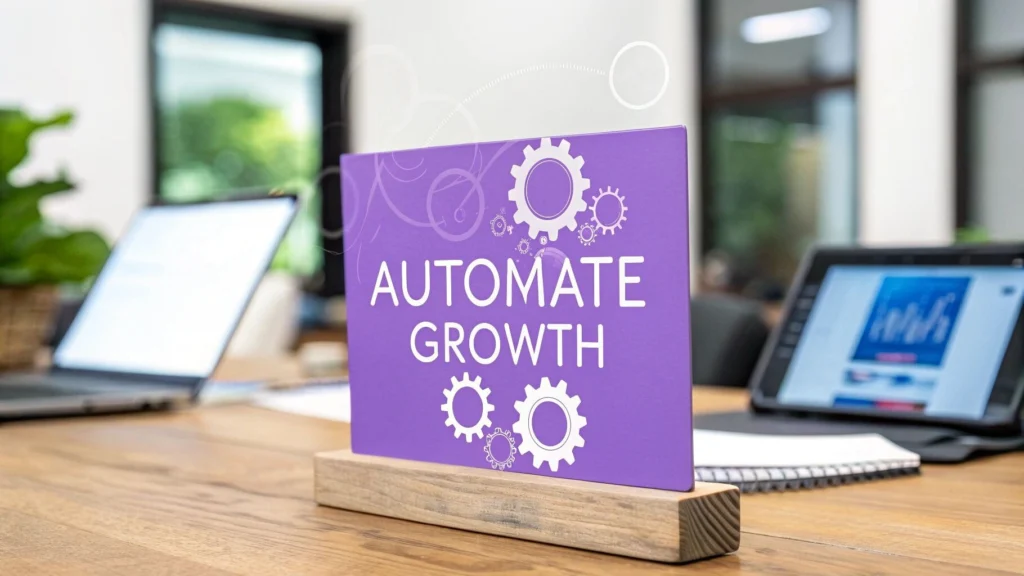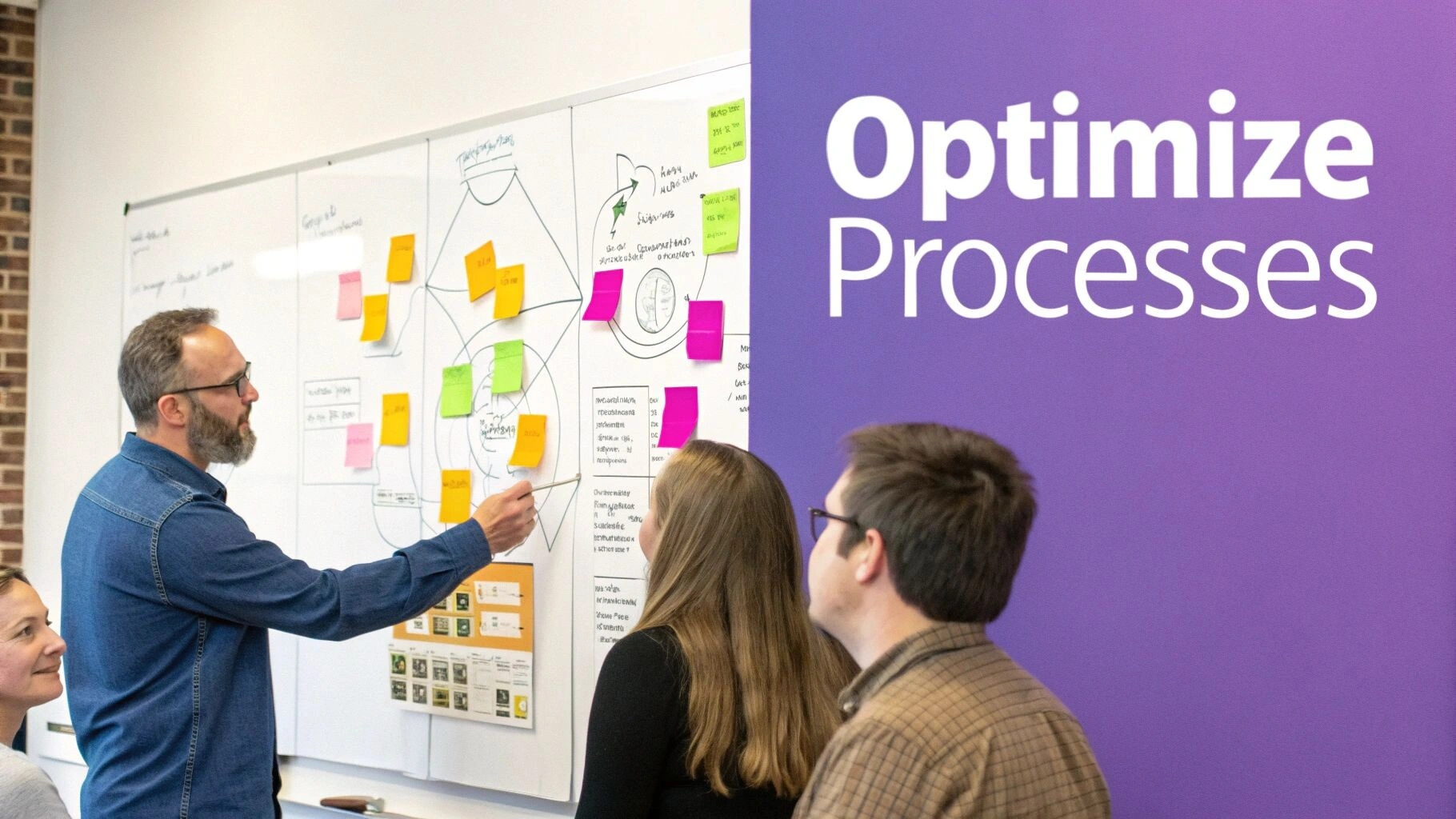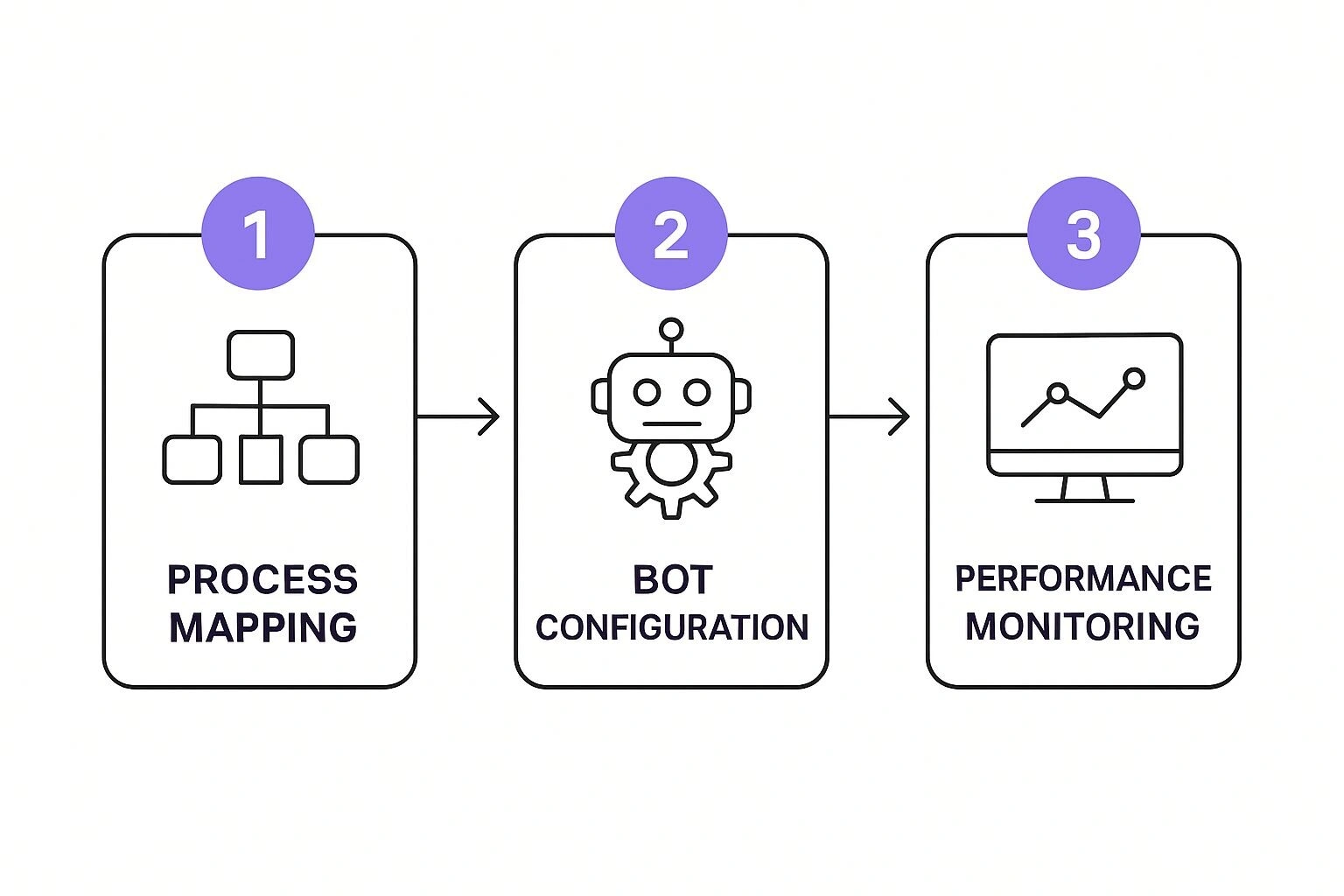Top Business Process Automation Solutions for Growth
Discover top business process automation solutions to streamline operations, reduce costs, and drive growth. A practical guide to transforming your business.

At its heart, a business process automation solution is simply a technology platform designed to handle the repetitive, rules-based tasks that bog down your team. Think of all the time spent on manual duties like data entry, chasing approvals, and compiling reports. BPA tools take over these jobs, which in turn reduces costs, minimises human error, and gets things done faster.
Moving Beyond Manual Workflows

Picture your business as a finely tuned orchestra. When you rely on manual processes, it’s like having a group of incredibly talented musicians playing without a conductor. They’re skilled, sure, but the result is often chaotic and out of sync. This disorganisation inevitably leads to frustrating bottlenecks, expensive mistakes, and a whole lot of wasted time.
This is where Business Process Automation (BPA) steps in. It acts as the conductor. It doesn’t replace your talented team (the musicians), but it provides the essential structure, timing, and direction needed to make every part work in perfect harmony. Suddenly, you have a masterpiece of efficiency, where every task is precise, coordinated, and contributes to a flawless performance.
From Chaos to Cohesion
At its core, BPA isn’t just about software; it’s a strategic approach to completely rethinking how work gets done in your organisation. It’s about consciously moving away from disjointed, manual tasks and building integrated, automated workflows that fundamentally expand your operational capacity.
Just think about the common headaches that manual processes cause every day:
- Time-Wasting Data Entry: Your staff spend hours just re-keying information from one system into another—a recipe for typos and delays.
- Approval Gridlock: An invoice or a simple request can languish in someone’s inbox for days, holding up entire projects while waiting for a single signature.
- Inconsistent Processes: Different people often handle the same task in slightly different ways, which leads to unpredictable results and quality control issues.
- A Total Lack of Visibility: How can you fix a problem you can’t see? With manual workflows, it’s almost impossible to know the real-time status of any given process.
Business process automation tackles these challenges head-on by establishing a single, dependable system for getting work done. It carves out a clear, digital path for tasks to follow, ensuring everything is consistent and transparent from beginning to end.
This isn’t just about shuffling digital papers around; it’s about securing a real competitive advantage. For example, one of the most powerful shifts a business can make is moving away from paper files by adopting modern document management systems, which transform chaotic paper trails into controlled, accessible digital assets.
Ultimately, by bringing in the right BPA solutions, you’re not just making things more efficient. You’re freeing your team from tedious admin and empowering them to focus on the high-value, strategic work that actually drives growth. This guide will give you a practical roadmap to help your business run smoother, faster, and with more precision than ever before.
The Building Blocks of Modern Automation

To really get a feel for what today’s business process automation can do, you need to look under the bonnet at the technologies that power it. Think of it like putting together a high-tech toolkit. Each tool has a specific job, but they deliver the best results when they work together. It’s this combination that creates the kind of powerful, end-to-end automation that can truly reshape how your business gets things done.
These components aren’t isolated; in fact, the smartest automation strategies weave them together. You might have an RPA bot handling data entry, an AI algorithm checking that data for oddities, and a workflow engine coordinating the entire sequence. Understanding what each piece does is the first step toward building a cohesive and effective automation strategy for your organisation.
Workflow Engines: The Foundation
At the base of the technology stack, you have workflow engines. These are the foundational platforms that give your processes structure and direct the flow of tasks from beginning to end. A workflow engine is like the central nervous system of your automation plan, making sure information and jobs move to the right person or system at precisely the right time.
For instance, when a new purchase order comes in, the workflow engine can instantly route it to the right manager for approval. As soon as it’s approved, it shoots the order over to the finance team for processing and pings the original requester. This locks in a consistent, predictable path every single time, putting an end to chaotic email chains and misplaced paperwork.
Robotic Process Automation: The Workhorse
Next in our toolkit is Robotic Process Automation (RPA). If workflow engines are the nervous system, then RPA bots are the tireless digital workers carrying out repetitive, rules-based tasks with perfect accuracy. These software ‘robots’ are designed to mimic human actions on a computer.
Think about the daily grind of copying customer details from a spreadsheet and pasting them into your CRM. An RPA bot can do that job 24/7 without needing a break or making a single error, freeing up your team to focus on more valuable work. This is often where businesses see their first big, tangible wins with automation.
The real value of RPA is its ability to chew through high-volume, predictable tasks with incredible speed and consistency. It’s the perfect fix for bridging the gap between older systems that lack modern APIs for easy integration.
AI and Machine Learning: The Intelligence
This is where things get really smart. Artificial Intelligence (AI) and Machine Learning (ML) are the brains of your automation toolkit. Unlike RPA bots, which just follow a script, AI and ML algorithms can learn from data, spot patterns, and make intelligent decisions or predictions. They add a layer of cognitive horsepower to your processes.
For example, AI can scan incoming customer support emails, figure out the customer’s intent and tone, and automatically assign the ticket to the best-suited agent. Over time, ML models can even predict which customers might be at risk of leaving based on their behaviour, allowing you to step in before it’s too late. Often, these advanced systems incorporate technologies like IoT building automation to connect and manage various physical and digital systems for peak efficiency.
Low-Code and No-Code Platforms: The Enabler
Finally, we have Low-Code and No-Code Platforms. These are the great enablers, making it possible for almost anyone to build automation solutions. With intuitive, visual interfaces and drag-and-drop tools, team members with little to no coding background can create and tweak their own automated workflows. This dramatically cuts down the reliance on specialised IT teams for every small process adjustment.
This trend is especially powerful in Australia, where the need for business agility is fuelling massive market growth. In fact, the Australian Business Process Management (BPM) market is projected to expand at a compound annual growth rate (CAGR) of around 22.7% between 2025 and 2030, with low-code tools being a major catalyst for this expansion.
The Real-World Payoff: What Automation Actually Does for Your Business

Let’s move past the technical jargon. The true test of any business process automation solution is what it delivers to your bottom line. Bringing in BPA isn’t just another IT project; it’s a direct investment in your company’s operational fitness and its ability to compete. The results are tangible, they’re measurable, and they build on each other to create a stronger, more adaptable business.
We’re not talking about abstract theories here. The advantages of automation are concrete solutions to the classic headaches that plague businesses: operational bottlenecks, bloated overheads, and the ever-present stress of compliance. These benefits work in concert to fundamentally reshape how your business runs and expands.
Unleash Productivity and Sharpen Employee Focus
One of the first things you’ll notice after implementing automation is a serious productivity spike. BPA is brilliant at handling the mind-numbing, high-volume tasks that eat up your team’s day. Just think about the collective hours spent on manual data entry, processing invoices, or pulling the same weekly reports.
Automation doesn’t just speed these tasks up; it takes them off the table entirely, letting work flow without constant human prodding. This frees your people from the drudgery. Instead of being stuck in administrative quicksand, they can focus their talent on the work that actually moves the needle—strategic planning, creative problem-solving, and building customer relationships.
Achieve Serious Cost Savings
Manual processes are expensive. It’s not just the labour costs; it’s the hidden price tag of human error. A single slip of the finger on a keyboard or a duplicated invoice can snowball into a significant financial issue that costs time and money to fix.
BPA tackles these financial leaks from several angles:
- Slashed Labour Costs: By automating routine jobs, you reduce the sheer number of person-hours needed for operations. That budget can then be channelled into growth-focused areas.
- Error-Proofing: Automated systems do the job with perfect precision, every single time. This gets rid of the costs that come from fixing mistakes and dealing with the fallout.
- Faster Cycles: Automation puts everything on fast-forward, from fulfilling an order to onboarding a new client. Quicker cycles mean you can handle more business and realise revenue sooner.
Implementing a business process automation solution is like performing a meticulous audit of your operational spending. It identifies and removes the hidden costs of inefficiency, leading to a leaner, more profitable organisation.
The financial impact isn’t trivial. Data shows that Australian firms embracing automation are seeing incredible efficiency gains. Some businesses report time savings of up to 30% on repetitive tasks and have cut errors by as much as 70% by integrating automation with their older systems. These integrations smooth out workflows and streamline the entire operation. You can dig deeper into these Australian automation trends to see the local impact.
Strengthen Compliance and Reduce Risk
In the current regulatory climate, compliance isn’t optional. Manual processes are a huge risk because they often lack a clear, documented trail. Proving that the correct steps were followed can become a nightmare, leaving your business exposed to fines and reputational harm.
Business process automation solutions bring a powerful level of control and governance. By standardising how work gets done, you guarantee every process follows your internal rules and external regulations to the letter.
Every single action within an automated system is logged, creating a transparent and unalterable audit trail. When the auditors show up, you can pull detailed records in an instant to demonstrate full compliance. This not only makes audits far less painful but also dramatically lowers your overall business risk, building a stronger operational foundation.
How to Choose the Right Automation Solution
With a sea of business process automation solutions on the market, picking the right one can feel daunting. The sheer volume of platforms, features, and pricing models is enough to make anyone’s head spin. But here’s a secret: the best place to start isn’t by looking at vendors, but by looking in the mirror.
The first, and most critical, step is an internal one. You need to get forensic about your own operations. Map out the business processes that are crying out for an upgrade. Where are your biggest bottlenecks? Which mind-numbing, repetitive tasks are killing your team’s productivity and spirit? Once you’ve pinpointed these specific pain points, you’ll have a crystal-clear set of requirements to guide your search.
This is a great visual for how an automation idea comes to life, from that initial mapping all the way to ongoing analysis.

What this really shows is that successful automation isn’t a “set and forget” project. It’s a living cycle of mapping, building, and monitoring. Get that internal clarity first, and you can step into the market with purpose and confidence.
Evaluate Scalability and Future Growth
One of the biggest mistakes I see is businesses choosing a tool for the company they are today, not the one they’ll be tomorrow. That’s why you have to think about scalability. The business process automation solution you pick now must be able to keep up as your organisation grows. A tool that’s perfect for a team of 50 might completely fall over when you hit 500 people.
Before you sign on the dotted line, ask the tough questions. How does the system cope with higher data volumes and more users? What does an upgrade path look like? Choosing a solution that can’t scale is just setting yourself up for a painful, expensive replacement project in a few years.
A scalable solution should be a foundation for growth, not a ceiling. It should empower your expansion, adapting to new processes, larger teams, and greater complexity without needing a complete overhaul.
Think of it like buying a car. A little hatchback is fine for zipping around the city. But if you know you’ll eventually be hauling a big family and all their gear, you’d be better off starting with an SUV. Your automation platform is that SUV—ready for the journey ahead.
Prioritise Seamless Integration Capabilities
In any modern business, no software works in isolation. Your new automation platform has to play nicely with your existing tech stack. This is why integration capabilities are absolutely non-negotiable.
The whole point is to create a unified, efficient system. That can only happen if the platform connects flawlessly with the tools your team already uses every single day, like your:
- Customer Relationship Management (CRM) system
- Enterprise Resource Planning (ERP) software
- Human Resources Information System (HRIS)
- Document Management platforms
Poor integration creates digital islands, forcing your people back into the exact manual data entry you wanted to escape. A well-integrated solution lets data flow automatically between systems, creating a single source of truth and a cohesive backbone for your entire operation.
Compare Solution Types for the Best Fit
Not all business process automation solutions are cut from the same cloth. They run the gamut from simple tools that automate one specific task to massive platforms that can run your entire enterprise. Getting to know the main categories will help you match your choice to your budget, goals, and the tech skills you have in-house.
To make sense of the options, it helps to break them down into a few key types. Each has its own strengths and is designed for different kinds of problems.
Comparing Business Process Automation Solution Types
This table compares key features and considerations for different types of BPA solutions to help businesses select the best fit for their needs.
| Solution Type | Best For | Key Advantages | Potential Drawbacks |
|---|---|---|---|
| Robotic Process Automation (RPA) | Automating high-volume, repetitive tasks in legacy systems. | Fast implementation, non-invasive, excellent for data entry. | Can be brittle; breaks if the underlying UI changes. |
| Low-Code/No-Code Platforms | Empowering business users to build their own simple automations. | High agility, reduces IT backlog, fosters innovation. | May lack enterprise-grade security and governance. |
| Business Process Management (BPM) | Orchestrating complex, end-to-end workflows across departments. | Robust, process-centric, provides deep visibility and control. | Longer implementation times, higher initial cost. |
| Integration Platform as a Service (iPaaS) | Connecting cloud applications and synchronising data between systems. | Excellent for API-driven automation, highly scalable. | Can be complex to configure without technical skill. |
Ultimately, choosing the right type of solution is about finding the sweet spot between your immediate needs and your long-term strategy. If you start by analysing your internal pain points, make scalability and integration your top priorities, and understand the different tools available, you’ll be in a much stronger position to make a smart decision that delivers real, lasting value.
Your Step-by-Step Implementation Roadmap
Choosing the right business process automation solution is a huge step, but it’s really only half the battle. The true value comes from a thoughtful, well-planned implementation. After all, a great tool is useless without a smart plan to roll it out.
To get from purchase to proficiency, you need a clear roadmap. Breaking the journey into distinct phases makes the entire project more manageable, helps get everyone on board, and ensures you actually see a return on your investment. It’s best to see this not as a one-time task, but as the first step towards a fundamentally more efficient way of working.
This roadmap breaks implementation down into four logical phases. Each stage builds on the one before it, creating a solid foundation that weaves your new automation capabilities right into the fabric of your business.
Phase 1: Planning and Discovery
Honestly, this first phase is the most important. Everything else hinges on the clarity you establish right now. Before you even think about designing a workflow, you have to define what success actually looks like for your business. Start by finding the high-impact, repetitive tasks that are currently causing the most headaches or eating up the most time.
Key activities to focus on here include:
- Defining Clear Goals: What are you trying to accomplish? Are you looking to cut invoice processing time by 50%? Maybe you want to stamp out data entry errors in HR or speed up how you onboard new clients. Fuzzy goals will only ever lead to fuzzy results.
- Pinpointing High-Impact Processes: Not every process is a good candidate for automation. Look for the ones that are rules-based, high-volume, and already well-understood. These are your “quick wins” that can prove the value of the project almost immediately.
- Engaging Stakeholders: Talk to the people who do these tasks day in and day out. Their hands-on insights are gold. They know the little quirks and frustrating bottlenecks that an outsider would completely miss.
Phase 2: Design and Development
With your goals set and your target processes chosen, it’s time to start building. This is where you translate your plans into real, working automated workflows inside your BPA software. It’s the point where theoretical efficiency starts to become a practical reality.
This involves carefully mapping out your current process—the “as-is”—and then designing the streamlined, automated “to-be” version. This isn’t just about making a digital copy of the old steps; it’s a chance to rethink the process entirely, making it leaner and more logical. You’ll be configuring business rules, connecting systems, and designing the interface your team will use.
Think of this stage as creating the architectural blueprint for your automation. A well-designed workflow ensures information flows seamlessly, approvals go to the right people, and any exceptions are handled smoothly. This prevents the automation itself from becoming a new bottleneck.
Phase 3: Testing and Deployment
Whatever you do, don’t roll out a new automated process across the entire company without putting it through its paces first. This phase is your quality control checkpoint. It’s designed to find and fix any problems in a controlled setting before they can affect your live operations.
Kick things off with a pilot program. Pick a small, representative group of users and have them test the new workflow with real-world tasks. This is your chance to gather honest feedback, uncover unexpected bugs, and fine-tune the process. This iterative approach is crucial for a smooth launch and for building people’s confidence in the new system. A successful pilot also becomes a powerful case study to encourage everyone else to get on board.
Phase 4: Monitoring and Optimisation
Going live isn’t the finish line. The most successful businesses treat automation as an ongoing cycle of improvement. Once your new process is up and running, you need to actively monitor its performance to make sure it’s delivering the results you expected. For any business with an eye on expansion, knowing how to track and refine these systems is fundamental to successfully scaling business processes for future growth.
Use the analytics and reporting tools built into your business process automation solution to keep an eye on key metrics. Watch your cycle times, error rates, and how well the team is adopting the new system. This data will shine a light on where you can make further improvements, helping you tweak rules, adjust workflows, and squeeze even more value out of your operations over time.
How Smart Automation Creates Better Customer Experiences
In today’s market, a brilliant customer experience isn’t just a nice-to-have; it’s one of the most powerful ways to stand out from the competition. While many people think business process automation solutions are all about back-office efficiency, their biggest impact is often felt directly by your customers. The logic is simple: when your internal operations are smooth, fast, and reliable, your customers feel it on the outside.
Think about it from a customer’s perspective. When you automate core processes like order fulfilment or inventory management, they see the results firsthand. Their orders show up faster, the stock levels on your website are actually accurate, and frustrating mistakes become a thing of the past. These aren’t small tweaks; they’re clear signs that you’re a capable organisation that respects their time and money. It’s how you turn operational gains into genuine customer loyalty.
Elevating Frontline Interactions
Upfront, automation delivers the speed and availability that modern consumers have come to expect. Things like AI-powered chatbots and automated support tickets can provide instant, 24/7 answers to common questions. This means customers aren’t left hanging.
This kind of immediate support is critical, especially in the Australian market. We’re seeing more and more local businesses bring their sales, marketing, and service teams together to create one seamless customer journey. The numbers back this up: 52% of Australian consumers expect a response within an hour, and a massive 75% appreciate having self-service options. Yet, there’s a big disconnect, with 39% of customers still reporting waits of over two hours for help. This gap is a huge opportunity where automation can make a real difference. For anyone wanting to dig into these market specifics, you can explore detailed findings on Australian BPA growth drivers.
By letting automation handle the high volume of simple, repetitive questions, you free up your skilled customer service professionals. They can stop answering the same queries all day and focus their expertise on solving the complex, nuanced problems that genuinely need a human touch.
This shift in focus lets your team provide real value where it counts most, turning customer service from a reactive cost centre into a proactive, relationship-building engine. This is a fundamental concept behind unlocking efficiency with business process automation—it’s about using technology to elevate what your people can achieve.
Building Proactive and Personalised Journeys
Smart automation doesn’t just react; it helps you get ahead of your customers’ needs. By pulling together data from your CRM, sales platform, and past support tickets, automated systems can spot patterns. They can see the triggers that suggest a customer might be running into trouble or is ready to explore a new feature.
This insight allows for proactive engagement that feels surprisingly personal and perfectly timed. Here are a few examples:
- Automated Follow-ups: A week after a purchase, an automated email could send a helpful ‘getting started’ guide or a simple check-in message.
- Personalised Offers: A customer’s browsing history or recent support query could trigger a special offer that’s actually relevant to them.
- Proactive Support: The system could identify a user who seems stuck on a particular feature and automatically offer a pop-up with help or a link to a tutorial.
Ultimately, these automated touchpoints—when designed thoughtfully—create a journey that feels supportive and seamless. They show your customers that you understand them, and that’s how you build the kind of trust-based relationships that fuel real, long-term growth.
Common Questions About Business Process Automation
As organisations start exploring business process automation, it’s natural for some practical questions to come up. Getting these sorted early on helps set the right expectations and builds confidence in what the technology can actually do for you. Let’s tackle some of the most common queries we hear from businesses just starting their automation journey.
Which Departments Benefit Most From BPA?
Honestly, almost any department can find a win with automation, but we typically see the quickest adoption in areas drowning in repetitive, rules-based work.
- Finance: This is a classic starting point. Automating invoicing, processing expense reports, and managing accounts payable or receivable workflows are often the first things to go on the chopping block.
- Human Resources: HR teams often automate employee onboarding, running payroll, and handling leave requests. It brings much-needed consistency and speed to these critical tasks.
- Operations: For operations, BPA is a game-changer for managing supply chain logistics, keeping inventory levels accurate, and running routine quality assurance checks.
- Customer Service: Think automated support tickets, instant responses to common queries, and routing customer issues to the right person without any manual hand-offs.
The best strategy? Start with a process where you can score a quick, measurable win. This builds momentum and gets everyone on board.
Is Business Process Automation Too Expensive for Small Businesses?
This is a big misconception, but it’s one based on outdated ideas. It’s true that years ago, automation meant massive, enterprise-level systems that required a huge upfront investment. That’s just not the case anymore.
The rise of scalable, cloud-based Software as a Service (SaaS) platforms and user-friendly low-code tools has put powerful automation well within reach for small and medium-sized businesses. Many providers now offer flexible pricing that scales with your usage, so you can start small and expand your automation efforts as your business grows.
Will Automation Replace Jobs in My Company?
The goal of BPA isn’t to replace your people; it’s to supercharge them. By taking the monotonous, repetitive tasks off their plates, you free them up to focus on the work that really matters—strategic initiatives, creative problem-solving, and high-value activities that require a human touch.
It’s like giving every team member a digital assistant to handle the grunt work, allowing them to tackle bigger challenges that drive real business growth. For a deeper look at this, you can learn more about what business process automation really means for your team.
How Long Until We See a Return on Investment?
The timeline for seeing a real return on your investment will depend on what you choose to automate—specifically, its complexity and volume. That said, it’s often much faster than people expect.
Many businesses start seeing significant benefits, like massive time savings and a dramatic drop in errors, within the first three to six months. Automating just one high-volume, time-consuming process, like invoice processing, can deliver a clear and rapid return all on its own.
Ready to unlock your team’s full potential and drive operational excellence? At Osher Digital, we specialise in designing and implementing business process automation solutions that deliver measurable results. Schedule a discovery call with Osher Digital today to find out how we can help you build a more efficient, scalable, and profitable business.
Jump to a section
Ready to streamline your operations?
Get in touch for a free consultation to see how we can streamline your operations and increase your productivity.